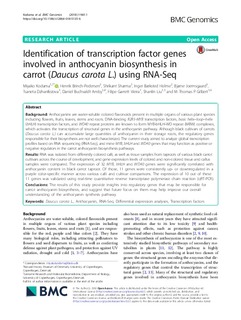| dc.contributor.author | Kodama, Miyako | |
| dc.contributor.author | Brinch-Pedersen, Henrik | |
| dc.contributor.author | Sharma, Shrikant | |
| dc.contributor.author | Holme, Inger B. | |
| dc.contributor.author | Joernsgaard, Bjarne | |
| dc.contributor.author | Dzhanfezova, Tsaneta | |
| dc.contributor.author | Amby, Daniel Buchvaldt | |
| dc.contributor.author | Vieira, Filipe G. | |
| dc.contributor.author | Liu, Shanlin | |
| dc.contributor.author | Gilbert, Marcus Thomas Pius | |
| dc.date.accessioned | 2019-09-03T06:21:14Z | |
| dc.date.available | 2019-09-03T06:21:14Z | |
| dc.date.created | 2018-11-13T15:51:46Z | |
| dc.date.issued | 2018 | |
| dc.identifier.citation | BMC Genomics. 2018, 19 (811), . | nb_NO |
| dc.identifier.issn | 1471-2164 | |
| dc.identifier.uri | http://hdl.handle.net/11250/2612112 | |
| dc.description.abstract | Background
Anthocyanins are water-soluble colored flavonoids present in multiple organs of various plant species including flowers, fruits, leaves, stems and roots. DNA-binding R2R3-MYB transcription factors, basic helix–loop–helix (bHLH) transcription factors, and WD40 repeat proteins are known to form MYB-bHLH-WD repeat (MBW) complexes, which activates the transcription of structural genes in the anthocyanin pathway. Although black cultivars of carrots (Daucus carota L.) can accumulate large quantities of anthocyanin in their storage roots, the regulatory genes responsible for their biosynthesis are not well characterized. The current study aimed to analyze global transcription profiles based on RNA sequencing (RNA-Seq), and mine MYB, bHLH and WD40 genes that may function as positive or negative regulators in the carrot anthocyanin biosynthesis pathways.
Results
RNA was isolated from differently colored calli, as well as tissue samples from taproots of various black carrot cultivars across the course of development, and gene expression levels of colored and non-colored tissue and callus samples were compared. The expression of 32 MYB, bHLH and WD40 genes were significantly correlated with anthocyanin content in black carrot taproot. Of those, 11 genes were consistently up- or downregulated in a purple color-specific manner across various calli and cultivar comparisons. The expression of 10 out of these 11 genes was validated using real-time quantitative reverse transcriptase polymerase chain reaction (qRT-PCR).
Conclusions
The results of this study provide insights into regulatory genes that may be responsible for carrot anthocyanin biosynthesis, and suggest that future focus on them may help improve our overall understanding of the anthocyanin synthesis pathway. | nb_NO |
| dc.language.iso | eng | nb_NO |
| dc.publisher | BioMed Central | nb_NO |
| dc.rights | Navngivelse 4.0 Internasjonal | * |
| dc.rights.uri | http://creativecommons.org/licenses/by/4.0/deed.no | * |
| dc.title | Identification of transcription factor genes involved in anthocyanin biosynthesis in carrot (Daucus carota L.) using RNA-Seq | nb_NO |
| dc.type | Journal article | nb_NO |
| dc.type | Peer reviewed | nb_NO |
| dc.description.version | publishedVersion | nb_NO |
| dc.source.pagenumber | 13 | nb_NO |
| dc.source.volume | 19 | nb_NO |
| dc.source.journal | BMC Genomics | nb_NO |
| dc.source.issue | 811 | nb_NO |
| dc.identifier.doi | 10.1186/s12864-018-5135-6 | |
| dc.identifier.cristin | 1630109 | |
| dc.description.localcode | Open Access This article is distributed under the terms of the Creative Commons Attribution 4.0 International License (http://creativecommons.org/licenses/by/4.0/), which permits unrestricted use, distribution, and reproduction in any medium, provided you give appropriate credit to the original author(s) and the source, provide a link to the Creative Commons license, and indicate if changes were made. | nb_NO |
| cristin.unitcode | 194,31,10,0 | |
| cristin.unitname | Institutt for naturhistorie | |
| cristin.ispublished | true | |
| cristin.fulltext | original | |
| cristin.qualitycode | 1 | |

